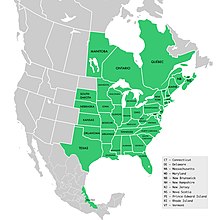Species of flowering plant in family Asteraceae
| Symphyotrichum lateriflorum
|

|
|
|
|
|
Scientific classification 
|
| Kingdom:
|
Plantae
|
| Clade:
|
Tracheophytes
|
| Clade:
|
Angiosperms
|
| Clade:
|
Eudicots
|
| Clade:
|
Asterids
|
| Order:
|
Asterales
|
| Family:
|
Asteraceae
|
| Tribe:
|
Astereae
|
| Subtribe:
|
Symphyotrichinae
|
| Genus:
|
Symphyotrichum
|
| Subgenus:
|
Symphyotrichum subg. Symphyotrichum
|
| Section:
|
Symphyotrichum sect. Symphyotrichum
|
| Species:
|
S. lateriflorum
|
| Binomial name
|
Symphyotrichum lateriflorum
|

|
| Native distribution
|
| Synonyms
|
|
Basionym
Most recently
Alphabetical list
- Aster acadiensis Shinners
- Aster agrostifolius E.S.Burgess
- Aster bellidiflorus var. rigidulus (Nees) DC.
- Aster bifrons Lindl. ex DC.
- Aster diffusus Aiton
- Aster diffusus var. bifrons (Lindl. ex DC.) A.Gray
- Aster diffusus f. bifrons (Lindl. ex DC.) Voss
- Aster diffusus var. hirsuticaulis (Lindl. ex DC.) A.Gray
- Aster diffusus f. hirsuticaulis (Lindl. ex DC.) Voss
- Aster diffusus var. horizontalis (Desf.) A.Gray
- Aster diffusus var. variifolius Peck
- Aster divaricatus Raf. ex DC.
- Aster divergens Aiton
- Aster divergens var. diffusus (Aiton) Nutt.
- Aster divergens var. humilior DC.
- Aster divergens var. pendulus (Aiton) Nutt.
- Aster hirsuticaulis Lindl. ex DC.
- Aster horizontalis Desf.
- Aster lateriflorus var. angustifolius Wiegand
- Aster lateriflorus var. bifrons (Lindl. ex DC.) Fernald
- Aster lateriflorus var. flagellaris Shinners
- Aster lateriflorus var. glomerullus E.S.Burgess
- Aster lateriflorus var. grandis Porter
- Aster lateriflorus var. hirsuticaulis (Lindl. ex DC.) Porter
- Aster lateriflorus var. horizontalis Farw.
- Aster lateriflorus var. indutus Shinners
- Aster lateriflorus var. pendulus E.S.Burgess
- Aster lateriflorus var. spatelliformis (E.S.Burgess) A.G.Jones
- Aster lateriflorus var. tenuipes Wiegand
- Aster leucanthemus Raf.
- Aster miser Nutt.
- Aster miser var. abbreviatus DC.
- Aster miser var. diffusus (Aiton) L.C.Beck
- Aster miser var. divergens (Aiton) L.C.Beck
- Aster miser var. glomerellus Torr. & A.Gray
- Aster miser var. hirsuticaulis (Lindl. ex DC.) Torr. & A.Gray
- Aster miser var. miserrimus Torr. & A.Gray
- Aster miser var. myrtifolius (Willd.) DC.
- Aster miser var. pendulus (Aiton) L.C.Beck
- Aster miser var. vimineus Farw.
- Aster myrtifolius Willd.
- Aster pendulus Aiton
- Aster recurvatus Günther ex Nees
- Aster rigidulus Nees
- Aster scoparius Nees
- Aster seliger Nees
- Aster spatelliformis E.S.Burgess
- Aster tenuipes (Wiegand) Shinners
- Aster tradescanti Michx.
- Aster vimineus var. columbianus Britton
- Aster vimineus var. dubius Wiegand
- Symphyotrichum lateriflorum var. angustifolium (Wiegand) G.L.Nesom
- Symphyotrichum lateriflorum var. flagellare (Shinners) G.L.Nesom
- Symphyotrichum lateriflorum var. hirsuticaule (Lindl. ex DC.) G.L.Nesom
- Symphyotrichum lateriflorum var. horizontale (Desf.) G.L.Nesom
- Symphyotrichum lateriflorum var. spatelliforme (E.S.Burgess) G.L.Nesom
- Symphyotrichum lateriflorum var. tenuipes (Wiegand) G.L.Nesom
- Venatris salicifolius Raf.
|
Symphyotrichum lateriflorum (formerly Aster lateriflorus) is a species of flowering plant in the aster family (Asteraceae). Commonly known as calico aster, starved aster, and white woodland aster, it is native to eastern and central North America. It is a perennial and herbaceous plant that may reach heights up to 120 centimeters (4 feet) and widths up to 30 centimeters (1 foot).
The flowers of calico aster are small compared to most Symphyotrichum species. They have an average of 7–15 short white ray florets, which are rarely tinted pink or purple. The flower centers, composed of disk florets, begin as cream to yellow and often become pink, purple, or brown as they mature. There are roughly 8–16 disk florets, each with five lobes that strongly reflex (bend backwards) when open. The mostly hairless leaves have a characteristic hairy midrib on their back faces, and branching is usually horizontal or in what can appear to be a zigzag pattern. Flower heads grow along one side of the branches and sometimes in clusters at the ends.
Symphyotrichum lateriflorum is a conservationally secure species and grows in a variety of habitats. It can be found throughout most of the eastern and east-central United States and Canada. There is also a native population in the state of Veracruz, Mexico. Its late-summer and fall appearing flowers are visited by small pollinators and nectar-seeking insects such as sweat bees, miner bees, and hoverflies. As well as occurring naturally in several varieties, S. lateriflorum has multiple cultivars and has been grown for at least 250 years in Europe. Some modern-day cultivars are 'Bleke Bet', 'Lady in Black', and 'Prince'. It has been used by Indigenous peoples of the Americas as a medicinal plant.


